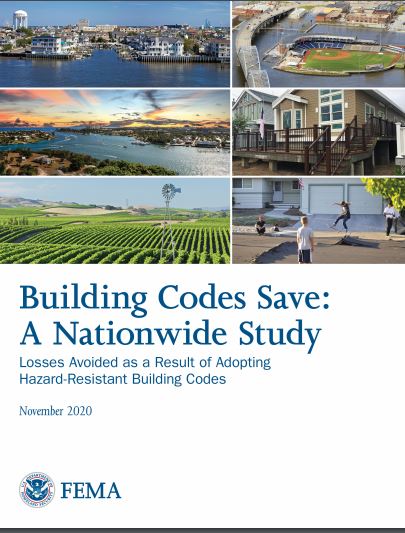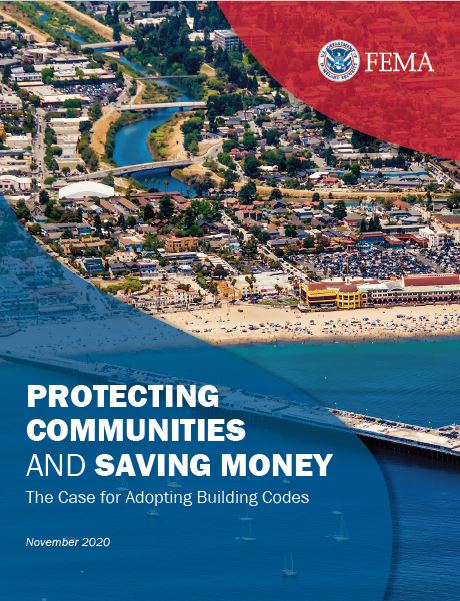
Codes Save
Up-To-Date Building Codes Support Safe, Sustainable and Resilient Communities
Building codes represent a highly cost-effective strategy to help protect communities from the risks posed by natural and man-made events. Two recent national studies affirm the significant benefits up-to-date building codes provide communities.
Building Codes Save: A Nationwide Study features an in-depth look at the quantified benefits—avoided losses to buildings and building contents—from adopting modern building codes and standards.
Alarmingly, the FEMA study found that currently 65 percent of counties, cities, and towns across the U.S. have not adopted modern building codes, only 50 percent of cumulative post-2000 construction adhered to the I-Codes, and 30 percent of new construction is occurring in communities with no codes at all or codes that are more than 20 years outdated.
Based on a database of more than 18 million actual buildings constructed since the inception of the I-Codes in 2000, the frequency of hazard events across the country, and the contents and edition of the International Residential Code (IRC) and International Building Code (IBC) in effect in each locality where post-2000 construction took place, the study found:
- The IRC and IBC provided more than $27 billion in cumulative mitigation benefits against flood, hurricane wind, and earthquake hazards from 2000 to 2016. These benefits could have been doubled if all post-2000 construction adhered to the I-Codes.
- If construction continues at the pace the study observed and if the proportion of that construction adhering to the I-Codes is consistent with the trend the study identifies, the I-Codes could help communities avoid $132 billion to $171 billion in cumulative losses through 2040.
- If all new buildings across the U.S. were built to modern editions of the I-Codes, the country would save more than $600 billion by 2060.
As FEMA’s materials make clear: “Adopting building codes is the single most effective thing we can do! One change in building codes can save lives and protect property for generations to come.”
FEMA has also released "Guide to Expanding Mitigation: Making the Connection to Codes and Standards," a guide that references the International Energy Conservation Code, International Plumbing Code, International Wildfire Urban Interface Code, and International Zoning Code and explains how communities benefit from diverse codes and standards. It can help officials, especially those in emergency management, start conversations about how codes can make communities more resilient. Download the guide here by clicking the button below.
A 2019 report, Natural Hazard Mitigation Saves, by the congressionally-established National Institute of Building Sciences (NIBS) found that adopting and enforcing the 2018 International Building Code (IBC) and International Residential Code (IRC) provides communities with an $11 benefit for every $1 invested. These benefits represent avoided casualties, property damage, business interruptions, first responder expenses, and insurance costs, and are enjoyed by all building stakeholders – from developers, titleholders, and lenders, to tenants and communities. FEMA’s Building Codes Save: A Nationwide Study affirmed this finding. The NIBS report also found that retrofitting structures to current codes’ flood mitigation requirements can provide $6 in mitigation benefits for every $1 invested and that retrofitting structures to the Code Council’s Wildland-Urban Interface Code could provide $2 to as much as $8 in mitigation benefits for each $1 invested.
Up to Date Building Codes Mitigate Risk – Additional Research
A number of studies demonstrate the value of up to date building codes as mitigation measures against natural hazards and the cost effectiveness of these efforts. One study found buyers paid an almost 6 percent premium for homes with hurricane shutters on Galveston Island, TX. Another study found resale premiums near 4 percent for homes with tornado shelters. Additional research has found that enacting enhanced codes in tornado country had no effect on the price per square foot or home sales.
The Department of Energy’s National Laboratories performed a 2023 study entitled Enhancing Resilience in Buildings Through Energy Efficiency, which provides standardized methodology and analysis demonstrating the value of building codes and above code measures to hazard resilience. The study reveals that improving envelope efficiency in buildings to meet or exceed current energy code requirements saves lives during extreme temperature events. Increasing the efficiency of the envelope in existing single-family buildings to meet code requirements of the 2021 IECC can reduce deaths by 80% during extreme heat and 30% during extreme cold events. For new buildings, benefit-cost ratio (BCR) values for meeting 2021 IECC envelope requirements range from 4 to 7 for single-family buildings, making a strong financial case for adoption.
Additional studies confirm that the adoption and implementation of current model building codes is one of the nation’s best defenses against the natural hazards. For example:
- An initial release from an ongoing FEMA analysis found that Florida and California's consistent adoption of the I-Codes (and their hazard mitigation provisions) since 2000 will provide long-term average future savings of $1 billion a year.
- The 2019 FEMA Mitigation Assessment Team (MAT) report following Hurricane Harvey found that National Flood Insurance Program (NFIP) regulations reduced average claim payments by almost half and following modern code requirements reduced the average claim payments by an additional 90%.
- In the ten years following Florida’s adoption of a statewide building code, the code’s adoption and application reduced windstorm actual losses by as much as 72 percent.
- Effective and well‐enforced building codes in Missouri reduced hail damage to homes by 10 to 20 percent on average.
- Although building code adoption alone generates enormous mitigation benefits, code enforcement is equally important. FEMA quantified the cost of Dade County Florida’s inadequate code enforcement as a quarter of the $16 billion in insured losses from Hurricane Andrew in 1992. Researchers found similar results about 15 years later: that implementing building codes at the local level by ensuring proper staffing, training, and certification provides an additional loss reduction value on the order of 15 to 25 percent.
How Do Codes Impact Housing Prices?
Pacific Gas and Electric Company (PG&E) developed a study analyzing the relationship between construction costs and home prices for Metropolitan Areas in California (CA) and the U.S. in relationship with implementation of CA’s Title 24 Energy Efficiency Code. The report concluded that construction cost growth is only marginally associated with home value growth and that there is no evidence an increase in construction cost will cause higher home prices in CA. The study determined that home construction costs are highly correlated to the national cost of inputs and there is no significant statistical evidence that CA’s energy efficiency code, Title 24, is associated with home construction costs.
What Edition of the Code is My Community On?
Building codes are adopted at the state and/or local level in the United States. The edition in place in a community varies widely. The Federal Alliance for Safe Homes’ (FLASH) InspectToProtect.org allows users to look up the codes applicable to a given residential address. FEMA's tracker of the adoption of hazard resistant building codes at the state and local levels across the U.S. can be viewed here. You can also view the Building Code Effectiveness Grading Schedule (BCEGS) National Building Code Assessment Report here for an in depth analysis of state code enforcement efforts. The below map tracks the adoption status of the most recent edition of the International Building and Residential Codes, including where adoptions are effective, where adoptions have a future effective date, and where the code is under review.
2018 I-Code Adoption Status
- Enacted statewide
- Enacted statewide with future effective date
- Statewide consideration underway
- Adopted and/or effective in some localities
- Local consideration underway
- No known statewide consideration
- No known local consideration
* 2020 Florida Building Code (FBC), was based upon the 2017 edition of the Florida Building Code. Updates to the 2018 I-Codes were considered, but not all 2018 I-Code updates were approved for inclusion in the 2020 FBC.
How Do States and Localities Adopt Building Codes?
The process for adoption at the state and local level varies, but typically allows for some level of public engagement. Learn how states adopt the International Codes (I-Codes). Sample ordinances are available to help communities get started in the adoption process.
How are Building Codes Developed?
The I-Codes are the most widely used and adopted set of building safety codes in the world. These model codes developed through a consensus process organized by the International Code Council that allows all interested parties to recommend changes. The final outcomes are voted on by state and local government officials that are charged with protecting health, safety and welfare in their communities. The I-Codes are updated every three years. Click here for additional information on the Code Council's Code Development Process.
Federal Support for Leveraging Codes in Promoting Resilient Communities
On August 14, 2019 the Mitigation Framework Leadership Group (MitFLG), chaired by the Federal Emergency Management Agency (FEMA), released the National Mitigation Investment Strategy (NMIS), a unified national strategy on mitigation investment that reduces risks posed by natural hazards and increases the nation’s resilience to disasters. The MitFLG is composed of 14 federal agencies and departments as well as state, tribal and local officials and is charged with coordinating the strategy’s implementation. The Strategy makes several recommendations concerning the use, enforcement, and adoption of building codes: “[a]rchitects, engineers, builders, and regulators should use the latest building codes for the most up-to-date requirements for structural integrity, mechanical integrity, fire prevention, and energy conservation,” “trained, certified professionals [should] handle building inspections and code administration,” and “[u]p-to-date building codes and standard criteria should be required in federal and state grants and programs. The NMIS devotes a section to encouraging communities to adopt and enforce up-to-date building codes.
The strategy’s focus on codes as a keystone mitigation investment strategy aligns with FEMA’s current strategic plan, and highlights that up-to-date building codes help communities survive, remain resilient, and continue to provide essential services after a disaster occurs. The NMIS notes that despite extensive research on codes’ mitigation benefits, only 32 percent of disaster-prone jurisdictions have adopted disaster-resistant building codes.
One of the most critical recommendations in the strategy with immediate implications is “Up-to-date building codes and standard criteria should be required in federal and state grants and programs.” To the Code Council’s knowledge, FEMA is currently the only federal agency that requires adherence to the latest codes and standards in a grant program. This recommendation has widespread existing support, including from bipartisan former FEMA administrators. It also builds on recent work by the Administration and Congress to leverage codes’ mitigation benefits. Twice last year – through the Bipartisan Budget Act and Disaster Recovery Reform Act – Congress passed, and the President signed into law, measures that incentivize the adoption and application of modern model building codes through enhanced federal cost shares for post-disaster rebuilding, new grants for states and localities both pre- and post-disaster, and by making pre-disaster mitigation grant applicants more competitive based on their adoption of up to date model codes.
ICC’s summary of the Disaster Recovery Reform Act can be viewed here.
Who Do I Call to Learn More or Get Help with Code Adoption Efforts?
The Who To Call Map contains links by state to ICC offices and staff members across the country who can assist with code adoption efforts and answer questions about our products and services. For information on international adoptions, please click here.



